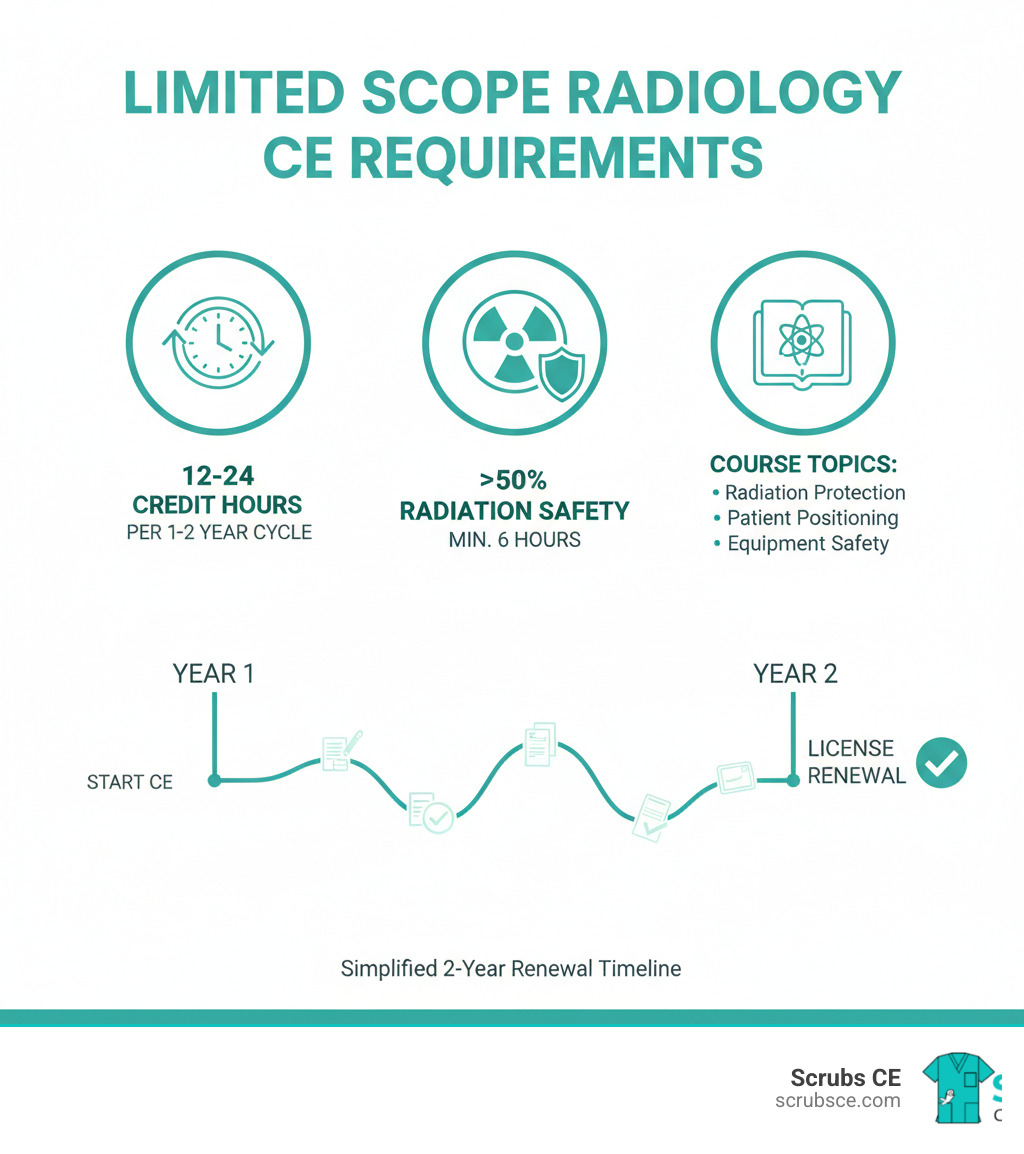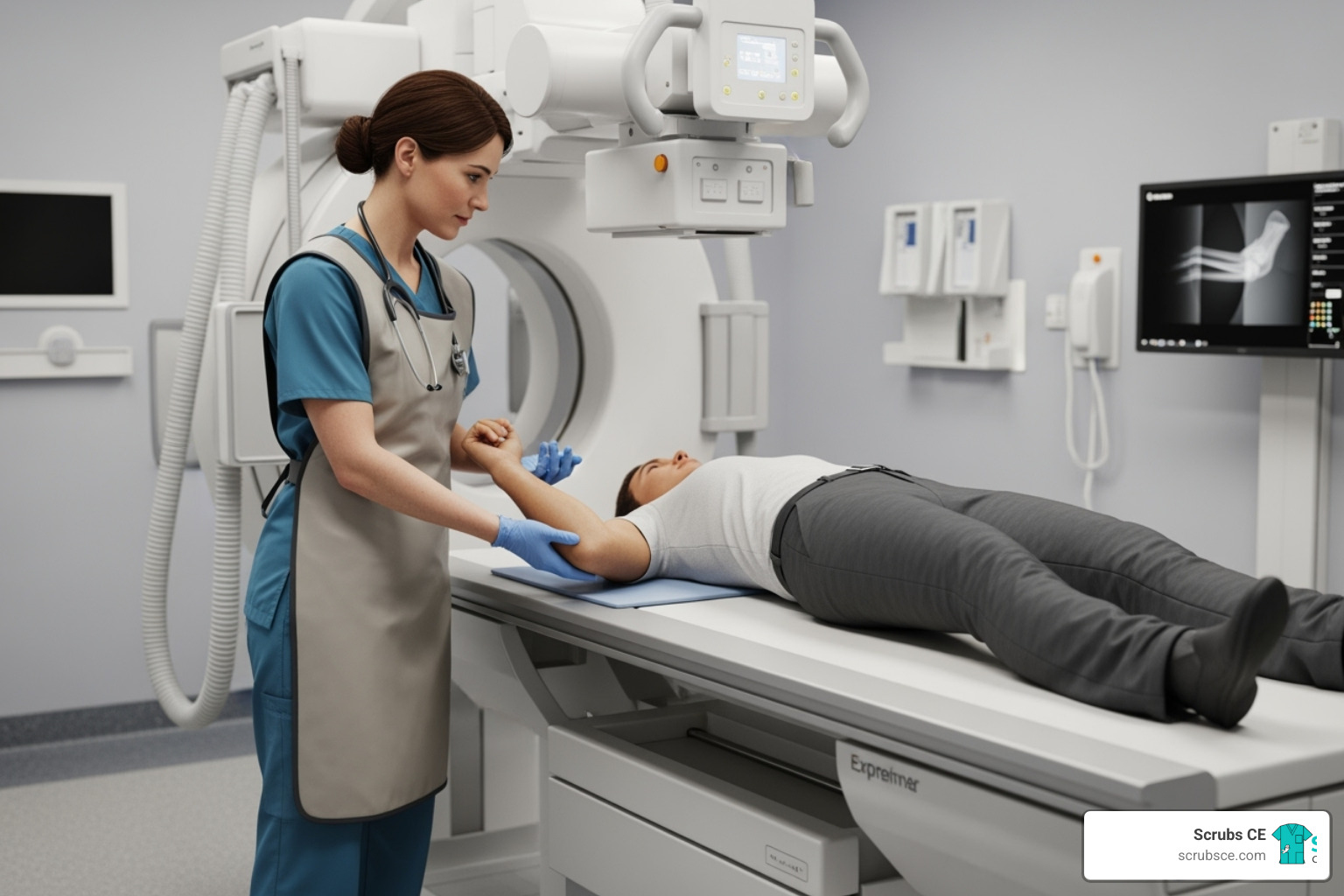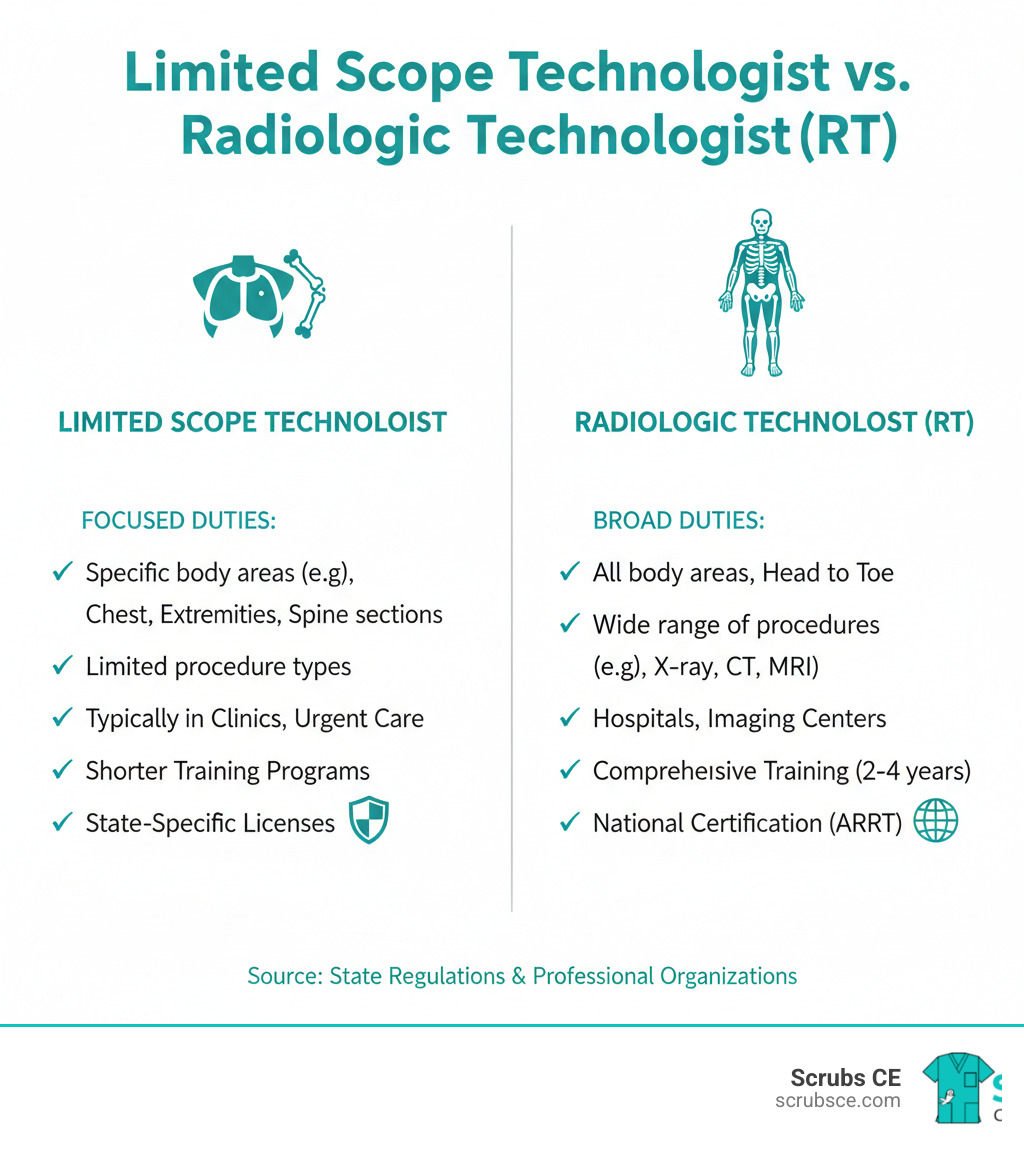Why Limited Scope X-Ray Techs Need to Understand CE Requirements
Limited license radiology CE is the continuing education required to maintain your limited scope x-ray technologist license. For Limited X-Ray Operators and Limited Medical Radiologic Technologists (LMRTs), CE isn’t optional—it’s mandatory for keeping your license active.
Key CE Requirements for Limited License Radiology:
- Credit Hours: Typically 12-24 hours every 1-2 years (varies by state)
- Radiation Safety: Many states require a minimum number of hours in this area.
- Approval: Look for ARRT Category A credits or state-specific approvals.
- Format: Online, self-paced courses are widely accepted.
- Cost: Expect $90-$165 per course or bundle.
The main challenge is that every state has different rules. For example, Mississippi requires 12 hours biennially with at least 6 in radiation safety, while Texas mandates 18 hours per biennium. California, Florida, and others have their own unique requirements.
Feeling overwhelmed by the different rules, costs, and course approvals is common. The good news is that understanding your state’s specific requirements and knowing where to find approved courses makes the process much simpler. This guide breaks down everything you need to know about limited scope CE, from credit types to finding affordable courses that meet your exact state requirements.
Introduction: Who is a Limited Scope X-Ray Technologist?
If you’re reading this, you’re likely working as or considering becoming a limited scope x-ray tech. Let’s start with the basics.
A Limited Scope X-Ray Technologist goes by several names, including Limited X-Ray Operator or Limited Medical Radiologic Technologist (LMRT). Whatever the title, the role is the same: you’re trained to perform a specific set of radiographic procedures, unlike a full Radiologic Technologist (RT) who performs a wider range.
Your role is specialized and essential to the healthcare settings where you work, such as urgent care clinics and orthopedic offices.
Defining the Role and Responsibilities
Your scope of practice is defined by state regulations and focuses on specific body areas. Most limited scope techs are authorized to perform chest x-rays and extremity imaging (hands, wrists, feet, ankles). Some states also permit limited spine imaging. These procedures are the bread and butter of urgent care clinics and orthopedic offices.
Your daily work involves positioning patients, operating equipment safely, acquiring quality images, and ensuring proper patient care and radiation protection. You typically work under the supervision of a physician or a fully certified radiographer, providing timely diagnostic imaging in settings where a full-time RT may not be necessary.
The Path to Becoming a Limited Tech
Becoming a limited tech is often more accessible than becoming a full RT. Most people complete shorter, focused initial training programs. Afterward, requirements vary by state. Some states require passing a state licensure exam, while others accept certification from recognized bodies like the ARRT through its ARRT Limited Scope Exam.
Certification paths can be flexible, sometimes accepting related coursework, military training, or work experience. However, clinical experience is always required to develop hands-on skills.
Getting your initial license or certification is just the beginning. Maintaining it requires ongoing education. That’s where limited license radiology ce comes in, and it’s the focus of this guide. Understanding your CE requirements is about maintaining your professional standing and providing the best patient care.
The “Why” Behind CE: Maintaining Your License and Skills
Continuing education can feel like just another requirement, but limited license radiology CE is vital for keeping your career active and your patients safe.
Medical technology and safety protocols are constantly evolving. Without CE, you risk falling behind. License renewal is the most immediate reason for CE; failing to complete the required hours means your license expires, and you can no longer legally work. For example, some certifications require 5 CE credits annually to remain current.
Beyond paperwork, patient safety is paramount. CE courses on radiation protection teach you how to minimize exposure, while updates on image quality reduce the need for repeat x-rays. Every credit earned translates to safer care.
CE also improves your skills and can lead to career advancement. Learning new positioning techniques or quality control procedures makes you a more valuable employee. It shows a commitment to professional growth that can open doors to supervisory roles and ensures you’re prepared for new technology, like an upgraded digital imaging system.
The Importance of ARRT Approval and CQR
The American Registry of Radiologic Technologists (ARRT) sets the standard for quality in our field. The ARRT requires its certified technologists to complete 24 CE credits every two years (a biennium). These must be “Category A” or “A-plus” credits, meaning they are approved by an ARRT-recognized body, ensuring the course content meets professional standards.
ARRT also has Continuing Qualifications Requirements (CQR), a 10-year cycle where technologists complete a Structured Self-Assessment (SSA) to identify and fill knowledge gaps. While CQR primarily applies to certain credentials, its principle is valuable for all techs: regularly assess your knowledge and actively seek education to improve.
Joining professional organizations like the American Society of Radiologic Technologists (ASRT) can simplify the CE process by providing access to a large library of approved courses.
Understanding CE Credit Types: Category A vs. Others
Not all CE credits are equal. Category A credits are the gold standard, as they are approved by a Recognized Continuing Education Evaluation Mechanism (RCEEM) and trusted by the ARRT. These credits are widely accepted by state licensing boards. Many of our courses at Scrubs CE are ASRT-approved, qualifying them as Category A.
CE topics can be directly related (e.g., radiation physics, positioning, image analysis) or indirectly related (e.g., patient care, medical ethics). States may also have rules about how many credits can be earned through self-study versus live formats.
Because of these variations, choosing Category A courses is your safest bet, as they have the broadest acceptance. Always verify what your specific licensing board accepts before enrolling in a course to ensure your time and money are well spent.
Navigating State-Specific Limited License Radiology CE Requirements
The biggest challenge for limited license X-ray technologists is that CE requirements vary dramatically from state to state. Unlike the more standardized national requirements for full radiologic technologists, there is no single blueprint for limited license radiology CE. Your requirements depend entirely on where you practice.
Each state sets its own rules on renewal frequency, credit hours (typically 6 to 24 per cycle), and mandatory topics, with most requiring a certain number of hours in radiation safety. This patchwork of regulations means a one-size-fits-all approach doesn’t work.
A Closer Look at Key States
Let’s examine a few states to see how diverse the regulations are. Remember to always verify these with your state’s official board, as rules can change.
| State | Total CE Hours | Renewal Cycle | Required Topics & Notes |
|---|---|---|---|
| California | 24 hours | 2 years | For Limited Permit X-ray Technicians. Must include 4 hours in digital radiography. |
| Texas | 18 hours | 2 years | For LMRTs. At least 9 hours must be directly related to ionizing radiation. A human trafficking prevention course is also required. See the Texas Medical Board for details. |
| Florida | 12 hours | 2 years | For Basic X-Ray Machine Operators (BXMO). |
Other states have different rules. For example, Mississippi requires 12 hours biennially (6 in radiation safety), and Arkansas requires 6 hours annually (3 in radiologic sciences). This diversity highlights why checking your own state’s rules is critical.
Finding and Completing Your CE Courses
Once you know your state’s requirements, the next step is finding and taking the courses. Thanks to online education, completing your limited license radiology ce has never been more convenient.
Most techs now use online courses for their flexibility. You can learn at your own pace, whether late at night or during a lunch break, without the need for travel. Platforms like Scrubs CE provide everything you need in one place: materials, quizzes, and instant certificates. You can explore options on our Continuing Education Courses for X-Ray Technologists page.
What to Look for in a Limited License Radiology CE Course
To ensure you’re investing your time and money wisely, look for courses with these key features.
First, verify accreditation and approval. ARRT Category A credits are the gold standard and widely accepted. If a course isn’t Category A, double-check that your state board accepts it for limited license renewal.
Next, evaluate the content. The course should cover topics relevant to your daily work. Key subjects include:
- Radiation Protection: Principles like time, distance, shielding, and radiation biology.
- Radiographic Image Analysis: Evaluating image quality and identifying artifacts or pathology.
- Patient Positioning: Techniques for projections within your scope of practice.
- Digital Radiography Principles: How CR and DR systems work, image processing, and dose effects.
- Medical Ethics: Patient safety, infection control, and professionalism.
Some comprehensive courses may require a specific textbook. For example, our Radiography Essentials for Limited Practice course uses a textbook, which we offer as an e-book and test bundle: Radiography Essentials for Limited Practice 6th ed.
Finding Affordable and Convenient CE Options
Continuing education doesn’t have to be expensive or complicated. Online providers are often the most affordable option, eliminating travel and lodging costs. At Scrubs CE, we focus on making limited license radiology ce accessible and convenient.
Look for course bundles or memberships to save money if you need multiple credits. Another key feature is instant certificates, which allow you to submit proof of completion to your state board without delay.
Before enrolling, check reviews from other technologists to gauge course quality. At Scrubs CE, we offer ASRT-approved Category A courses that are convenient and affordable. You can browse our full catalog on our All Courses page or check out our Radiography Prep course.
Frequently Asked Questions about Limited Scope Radiology CE
Navigating CE requirements can be confusing. Here are answers to the most common questions we hear from limited scope X-ray technologists.
What are the typical CE requirements for limited license radiology ce?
Typically, you’ll need 12 to 24 credit hours over a one-to-two-year renewal cycle (biennium). However, the exact number is determined by your state. For example, Texas requires 18 hours every 24 months, while Arkansas requires 6 hours annually.
Most states also mandate a specific number of hours in radiation safety (often 6 or more per cycle). Some states may also limit the number of credits you can earn through self-study. The key takeaway is to always check your specific state’s requirements.
How do I know if a CE course is approved for my limited license?
This is a critical step. To ensure a course will count toward your renewal, follow these steps:
- Look for ARRT Category A approval. This is the gold standard in radiologic technology. Courses approved by the ASRT, like those at Scrubs CE, qualify as Category A.
- Verify with your state licensing board. ARRT approval doesn’t automatically guarantee state acceptance for a limited license. Some states have their own approval systems. Always check your board’s website or contact them directly.
- Check the content. Ensure the course topics, such as radiation protection, positioning, and image analysis, are relevant to your limited scope of practice.
Reputable providers will be transparent about their accreditations. This is a good sign that the credits will be recognized.
Can I use the same CE credits for my ARRT renewal and my state license?
Yes, in many cases, you can. This is a huge time-saver. If your state accepts ARRT Category A credits, then a single ASRT-approved course can often satisfy both your ARRT biennial requirement and your state license renewal.
However, exceptions exist. Some states have unique requirements that must be met separately. For example, Texas requires a specific human trafficking prevention course for state licensure that does not count toward ARRT CE. Similarly, if you participate in ARRT’s Continuing Qualifications Requirements (CQR), the CE you complete for that process can often be applied to your biennial requirements.
Always double-check with both your state board and ARRT (if applicable) to confirm that your chosen credits will work for both. Keep detailed records of your completion certificates for documentation.
Conclusion: Invest in Your Career with Quality CE
We’ve covered the essentials of limited license radiology ce, from understanding your role to navigating state-specific requirements. We hope this guide has made the process feel more manageable.
Continuing education is an investment in your skills, confidence, and ability to provide excellent patient care. Every course you take makes you a better, more knowledgeable professional, which matters for your career and for every patient you serve.
While requirements vary and tracking credits can seem complex, you’re not alone. With the right resources, staying current can become a seamless part of your professional life.
At Scrubs CE, we understand the demands on your time and budget. We’ve built our platform to provide convenient, ASRT-approved Category A online courses that you can complete at your own pace. With instant certificates and clear guidance, we make meeting your CE requirements straightforward.
Your commitment to lifelong learning is what sets you apart. When you’re ready to take the next step, we’re here to help.
Ready to knock out your CE requirements with confidence? Explore our comprehensive Radiography Essentials course for limited practice and see how simple staying current can be.






Recent Comments